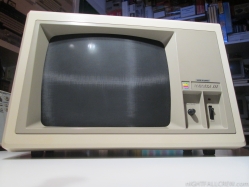
Autopsy:
from Wikipedia:
The Apple Monitor /// was a green phosphor CRT-based monochrome monitor manufactured by Apple Computer for the Apple III personal computer, introduced in 1980.
As Apple’s first monitor in their business line of machines, it preceded the Apple Monitor II by several years. The Apple Monitor ///’s main feature was the coating on the CRT to reduce glare. The Apple Monitor /// was also compatible with the Apple II+, Apple IIe, Apple IIc, and even the later models: the Apple IIc+, and the Apple IIgs through its composite video output jack.
source: wikipedia
![Apple Disk II Drive (Disk ][) Apple Disk II Drive (Disk ][)](https://www.nightfallcrew.com/wp-content/gallery/cache/8572__545x409_IMG_6818.jpg?76c919)
Autopsy:
from Wikipedia:
The Disk II Floppy Disk Subsystem, often spelled as Disk ][, was a 5¼-inch floppy disk drive designed by Steve Wozniak and manufactured by Apple Computer. It was first introduced in 1978 at a retail price of US$495 for pre-order; it was later sold for $595 including the controller card (which can control up to two drives) and cable. The Disk II was designed specifically for use with the Apple II personal computer family to replace the slower cassette tape storage and cannot be used with any Macintosh computer without an Apple IIe Card as doing so will damage the drive and/or controller.
Apple produced at least six variants of the basic 5¼-inch Disk II concept over the course of the Apple II series’ lifetime: The Disk II, the Disk III, the DuoDisk, the Disk IIc, the UniDisk 5.25″ and the Apple 5.25 Drive. While all of these drives look different and they use four different connector types, they’re all electronically extremely similar, can all use the same low-level disk format, and are all interchangeable with the use of simple adapters, consisting of no more than two plugs and some wires between them. Most DuoDisk drives, the Disk IIc, the UniDisk 5.25″ and the AppleDisk 5.25″ even use the same 19-pin D-Sub connector, so they are directly interchangeable. The only 5.25″ drive Apple sold aside from the Disk II family was a 360k MFM unit made to allow Mac IIs and SEs to read PC floppy disks.
This is not the case with Apple’s 3.5″ drives, which use several different disk formats and several different interfaces, electronically quite dissimilar even in models using the same connector, and are not generally interchangeable.
source: wikipedia

Autopsy:
from Wikipedia:
The Apple IIe (styled as Apple //e) is the third model in the Apple II series of personal computers produced by Apple Computer. The e in the name stands for enhanced, referring to the fact that several popular features were now built-in that were only available as upgrades and add-ons in earlier models. It also improved upon expandability and added a few new features, which, all combined, made it very attractive to first-time computer shoppers as a general-purpose machine. The Apple IIe has the distinction of being the longest-lived computer in Apple’s history, having been manufactured and sold for nearly 11 years with relatively few changes.
 Apple had planned to retire the Apple II series after the introduction of the Apple III in 1980; after that machine turned out to be a disastrous failure, management decided the further continuation of the Apple II was in the company’s best interest. So after three and a half years at a stand-still, came the introduction of a new Apple II model — the Apple IIe (codenamed “Diana” and “Super II”). The Apple IIe was released in January 1983, the successor to the Apple II Plus. Some of the hardware and software features of the Apple III were borrowed in the design of the Apple IIe. The culmination of these changes led to increased sales and greater market share of both home and small business use.
Apple had planned to retire the Apple II series after the introduction of the Apple III in 1980; after that machine turned out to be a disastrous failure, management decided the further continuation of the Apple II was in the company’s best interest. So after three and a half years at a stand-still, came the introduction of a new Apple II model — the Apple IIe (codenamed “Diana” and “Super II”). The Apple IIe was released in January 1983, the successor to the Apple II Plus. Some of the hardware and software features of the Apple III were borrowed in the design of the Apple IIe. The culmination of these changes led to increased sales and greater market share of both home and small business use.
One of the most notable improvements of the Apple IIe is the addition of a full ASCII character set and keyboard. The most important addition is the ability to input and display lower-case letters. Other keyboard improvements include four-way cursor control and standard editing keys (Delete and Tab), two special Apple modifier keys (Open and Solid Apple), and a safe off-to-side relocation of the “Reset” key. The auto-repeat function (any key held down to repeat same character continuously) is now automatic, no longer requiring the “REPT” key (now gone) found on the previous model’s keyboard.
source: wikipedia
Apple II Keyboard for Spare Parts donated by Paolo Cognetti. Thanks Paolo.
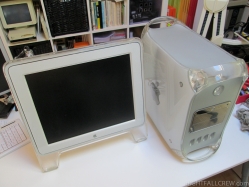
Autopsy:
from Wikipedia:
The Power Mac G4 was a series of personal computers that was designed, manufactured, and sold by Apple between 1999 and 2004.
They used the PowerPC G4 (PPC74xx) series of microprocessors. They were heralded by Apple to be the first personal supercomputers, reaching speeds of 4 to 20 Gigaflops. They were both the last Macintoshes to boot natively into Classic Mac OS and the first to boot exclusively into Mac OS X.
The original Apple Power Mac G4, code name “Yikes!”, was introduced at the Seybold conference in San Francisco on August 31, 1999, with 400 MHz, 450 MHz and 500 MHz configurations available. In October 1999, Apple was forced to postpone the 500 MHz because of poor yield of the 500 MHz chips. In response, Apple “speed dumped” the processor speed in each configuration by 50 MHz but caused some controversy by not decreasing the price of the machines.
Another generation of Apple Power Mac G4s were introduced on August 13, 2002, featuring both a new Xserve-derived DDR motherboard architecture and a new case design, known as “Mirrored Drive Doors” (MDD). All models were available in dual processor configurations running at 867 MHz, 1 GHz or 1.25 GHz. As with the Xserves, the PowerPC 7455 CPU used does not have a DDR frontside bus, meaning the CPU could only use at most 50% of the new system’s theoretical memory bandwidth, providing no improvement over previous models. The rest was available to the graphics card and I/O systems. A dual processor 1.25 GHz model would be the last Power Mac G4 the company offered to the public after the announcement of the new Power Mac G5, introduced in June 2003.
source: wikipedia

Autopsy:
from Wikipedia:
The iMac is a range of all-in-one Macintosh desktop computers built by Apple. It has been the primary part of Apple’s consumer desktop offerings since its introduction in 1998, and has evolved through five distinct forms.
The announcement of the iMac in 1998 was a source of discussion and anticipation among commentators, Mac fans, and detractors. Opinions were divided over Apple’s drastic changes to the Macintosh hardware. At the time, Apple was trying to improve its retail strategy. Apple declared that “the back of our computer looks better than the front of anyone else’s”.
Apple declared the ‘i’ in iMac to stand for “Internet”; it also represented the product’s focus as a personal device (‘i’ for “individual”). Attention was given to the out-of-box experience: the user needed to go through only two steps to set up and connect to the Internet. “There’s no step 3!” was the catch-phrase in a popular iMac commercial narrated by actor Jeff Goldblum.
Another commercial, dubbed “Simplicity Shootout”, pitted seven-year-old Johann Thomas and his border collie Brodie, with an iMac, against Adam Taggart, a Stanford University MBA student, with an HP Pavilion 8250, in a race to set up their computers. Johann and Brodie finished in 8 minutes and 15 seconds, whereas Adam was still working on it by the end of the commercial. Apple later adopted the ‘i’ prefix across its consumer hardware and software lines, such as the iPod, iBook, iPhone, iPad and various pieces of software such as the iLife suite and iWork and the company’s media player/store, iTunes.
source: wikipedia

Autopsy:
from Wikipedia:
The Power Macintosh 4400 (also known as the Power Macintosh 7220 in some markets) was a mid-to-high-end Macintosh personal computer designed, manufactured and sold by Apple Computer from 1996 until 1998. The Power Macintosh 4400 was rather different from most other Macintosh models, in that the floppy disk drive is on the left rather than right, and like the Centris 650, the casing is made of metal rather than plastic. Apple did this to reduce production costs, and in addition also used more industry standard components.
It was also available in a PC compatible system with a 166 MHz DOS card containing 16 Mb of RAM. The first 4400 model was only sold to the Europe market, an updated 200 MHz 603e model was released in the United States in February 1997 as the Power Macintosh 4400.
The Power Macintosh 4400 is known as the Power Macintosh 7220 in Australia and Asia, where the number 4 is considered unlucky. The machine was always considered a bit of an oddball, and had a reputation as being one of Apple’s less well designed and performing machines.
source: wikipedia
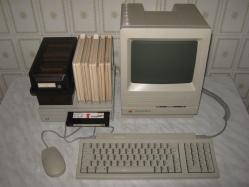
Autopsy:
The Macintosh SE/30 is a personal computer that was designed, manufactured and sold by Apple Computer, Inc. from 1989 until 1991. It was the fastest and most expandable of the original black-and-white compact Macintosh series.
The SE/30 is essentially a Macintosh IIx in the same case as the Macintosh SE, with a black-and-white monitor and a single PDS slot (rather than the NuBus slots of the IIx) which supported third-party accelerators, network cards, or a display adapter. Although officially only able to support 32 MB, the SE/30 could expand up to 128 MB of RAM (a ludicrous amount of RAM at the time), and included a 40 or 80 MB hard drive.
It was also the first compact Mac to include a 1.44 MB high density floppy disk drive as standard (late versions of the SE had one, but earlier versions did not). In keeping with Apple’s practice from the Apple II+ until the Power Macintosh G3 was announced, a logic board upgrade was available to convert a regular SE to a SE/30. The SE would then have exactly the same specs as an SE/30, with the difference only in the floppy drive if the SE had a 800k drive. The set included a new front bezel to replace the original SE bezel with that of an SE/30.
source: wikipedia
Macintosh SE/30 Fixing Motherboard Faults.
I spent many months (eight) to repair some of these macintosh SE/30 motherboard, like you can see in the gallery.
The flaws that i could find and repair are:
- Some multiplexers (74F253 or like) burned.
- Some Video Ram burned.
- Very Dirty Motherboard.
- Electrolytic capacitors have to be replaced.
- Reseat the RAM and ROM SIMM.
- Some track of the PCB broken or corroded by the acid.
- Replaced the lithium battery with a new one.
- Cold solder joint on chip: RP4/RP5/RP6 – UI2/UI3/UI4 – UJ2/UJ3/UJ4
The flaw that you see in the first picture and that should be the “Jail Bar Pattern” or “Smile Mac in Jail”, in this case is not been so. For this reason i spent a long time to find the fault.
However, i recovered 3 motherboards and I consider myself quite satisfied.
source: Repair Macintosh SE/30 68kmla.org #1 68kmla.org #2
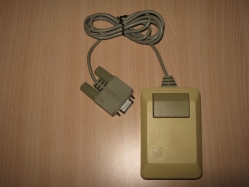
Autopsy:
Many thanks to Nilo for the Apple IIc Mouse.
Apple Inc. is responsible for the mouse interface standard used by today’s computers.
Apple did not invent the mouse, but just like Apple’s popularization of the graphical operating system, the company made the mouse a fundamental part of the personal computer. The Apple mouse has been evolving since the early days of Lisa and Apple II.
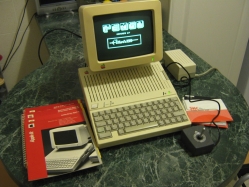
Autopsy:
Many thanks to Nilo for the Monitor.
This is the 9″ monochrome CRT display for Apple IIc, and the stand! Both are in great shape and the monitor works very well.
This is a Joystick Adapter for Apple IIc, with this adapter you can use the Apple ][ Plus Joystick.
Joystick Adapter Pinouts:
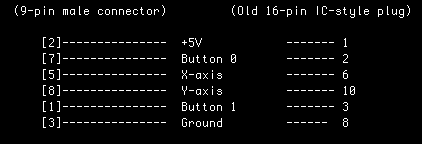
![Apple ][ Plus Analog Joystick Apple ][ Plus Analog Joystick](https://www.nightfallcrew.com/wp-content/gallery/cache/2448__250x187_IMG_5021.jpg?76c919)
Autopsy:
Thanks to Maiom (Macintosh All-In-One Museum)
Today i picked up a Apple ][ Plus Analog Joystick in original box, it is in perfect working condition.

Autopsy:
Apple IIc Box / Manuals / Warranty Card…
source: wikipedia

Autopsy:
Analog Joystick for Apple IIc/IIe. source: wikipedia
















![Apple Disk II Drive (Disk ][) Apple Disk II Drive (Disk ][)](https://www.nightfallcrew.com/wp-content/gallery/cache/8572__545x409_IMG_6818.jpg?76c919)
![Apple Disk II Drive (Disk ][) Apple Disk II Drive (Disk ][)](https://www.nightfallcrew.com/wp-content/gallery/apple-disk-ii-drive-disk/thumbs/thumbs_IMG_6816.jpg?76c919)
![Apple Disk II Drive (Disk ][) Apple Disk II Drive (Disk ][)](https://www.nightfallcrew.com/wp-content/gallery/apple-disk-ii-drive-disk/thumbs/thumbs_IMG_6818.jpg?76c919)
![Apple Disk II Drive (Disk ][) Apple Disk II Drive (Disk ][)](https://www.nightfallcrew.com/wp-content/gallery/apple-disk-ii-drive-disk/thumbs/thumbs_IMG_6820.jpg?76c919)
![Apple Disk II Drive (Disk ][) Apple Disk II Drive (Disk ][)](https://www.nightfallcrew.com/wp-content/gallery/apple-disk-ii-drive-disk/thumbs/thumbs_IMG_6812.jpg?76c919)
![Apple Disk II Drive (Disk ][) Apple Disk II Drive (Disk ][)](https://www.nightfallcrew.com/wp-content/gallery/apple-disk-ii-drive-disk/thumbs/thumbs_IMG_6822.jpg?76c919)





















































































































![Apple ][ Plus Analog Joystick Apple ][ Plus Analog Joystick](https://www.nightfallcrew.com/wp-content/gallery/cache/2448__250x187_IMG_5021.jpg?76c919)
![Apple ][ Plus Analog Joystick Apple ][ Plus Analog Joystick](https://www.nightfallcrew.com/wp-content/gallery/apple-plus-analog-joystick/thumbs/thumbs_IMG_5021.jpg?76c919)
![Apple ][ Plus Analog Joystick (boxed) Apple ][ Plus Analog Joystick (boxed)](https://www.nightfallcrew.com/wp-content/gallery/apple-plus-analog-joystick/thumbs/thumbs_IMG_5022.jpg?76c919)
![Apple ][ Plus Analog Joystick (inside) Apple ][ Plus Analog Joystick (inside)](https://www.nightfallcrew.com/wp-content/gallery/apple-plus-analog-joystick/thumbs/thumbs_IMG_5008.jpg?76c919)
![Apple ][ Plus Analog Joystick (detail) Apple ][ Plus Analog Joystick (detail)](https://www.nightfallcrew.com/wp-content/gallery/apple-plus-analog-joystick/thumbs/thumbs_IMG_5010.jpg?76c919)
![Apple ][ Plus Analog Joystick (detail) Apple ][ Plus Analog Joystick (detail)](https://www.nightfallcrew.com/wp-content/gallery/apple-plus-analog-joystick/thumbs/thumbs_IMG_5012.jpg?76c919)
![Apple ][ Plus Analog Joystick (detail) Apple ][ Plus Analog Joystick (detail)](https://www.nightfallcrew.com/wp-content/gallery/apple-plus-analog-joystick/thumbs/thumbs_IMG_5016.jpg?76c919)




















Recent Comments